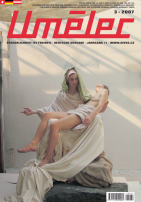|
In the Fifties, Andy Warhol’s technique of massive silkscreen reproductions brought on the collapse of the Avant Garde’s search for an object or theme that would be a subject of artistic interpretation in any and all areas. For Warhol, art did not effect or imitate life; life was an art in itself, a view which bestowed importance on moments and reshaped the experience of everyday life in its entirety. Living in Mexico City, it is inevitable that I think of Warhol every morning, as I find the front pages of newspapers practically slippery with blood, showing an execution or decapitation, or perhaps, as in yesterday’s paper, photographs of a child beaten to death and bitten by his adolescent mother. Violence in art is not a theme that little has been written about; however, as theorists say, it has always been explored from the “obsolete” paradigm of aesthetics. These graphic photos taken by the journalists of this city—do they possess any aesthetic value? And if not, why not? How is it that around the world there are exhibitions of illustrations, paintings and video pieces that portray violence through artifice, yet it is neither artistically, nor politically correct to have an exhibition that celebrates, say, the decades of news photography in “La Prensa,” a model of yellow journalism? In the last few years, this country has undertaken a superfluous search for that which defines our identity. Indeed, we have adopted fashions that try to replicate "indigenous and folk" customs and traditions, but do so by stripping them of their meaning and through recontextualizing them in pricey textile designs or commercialized industries. We try to realize the creation of a market for original national products, all the while exalting our name in stock markets for creating jobs in different and distant communities. All this notwithstanding, it is worthwhile to examine the authenticity of this cultural richness; is this apparent peace and harmony between diverse towns enough to define a country? Would not the violence, corruption and terrible crimes committed by members of government and society be a more truthful identification card? Would it not be more useful to present our own reality as it is, rather than turn to other more cosmopolitan latitudes to disguise ourselves in international style, leaving us laundered of all our natural crudity? The first option could result in an exercise of reflection, possibly with the participation of all citizens, through which we could confront ourselves, from the worst part of our identity, the worst of our reality. Sadly, the benefits that this could bring to artists and galleries cannot be seen, and we continue to delight ourselves in our caramelized society and cultural production— its internationality and its convenient ambiguity.

Recommended articles

|
|
There is nothing that has not already been done in culture, squeezed or pulled inside out, blown to dust. Classical culture today is made by scum. Those working in the fine arts who make paintings are called artists. Otherwise in the backwaters and marshlands the rest of the artists are lost in search of new and ever surprising methods. They must be earthbound, casual, political, managerial,…
|

|
|
Author dreaming of a future without censorship we have never got rid of.
It seems, that people don‘t care while it grows stronger again.
|

|
|
Nick Land was a British philosopher but is no longer, though he is not dead. The almost neurotic fervor with which he scratched at the scars of reality has seduced more than a few promising academics onto the path of art that offends in its originality. The texts that he has left behind are reliably revolting and boring, and impel us to castrate their categorization as “mere” literature.
|

|
|
"In Cameroon, rumours abound of zombie-labourers toiling on invisible plantations in an obscure night-time economy."
|
|







Comments
There are currently no comments.Add new comment